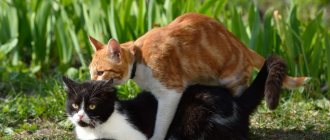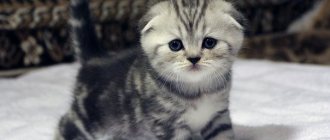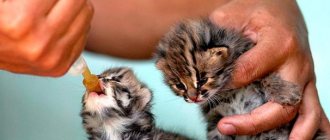Help the cat
The pet pleased the owners. Squeaking lumps were born. If the cat has given birth for the first time, the litter should not be too large. From 3 to 6 kids is ideal.
The mother is able to feed this number of kittens normally. If there are more of them, you will have to introduce complementary foods for the kittens, or, more correctly, supplementary feeding.
For these purposes, you can buy a cat's milk replacer. It is sold in good pet stores. It's not cheap, let's warn you right away.
You can make a substitute yourself. It is different from the store bought one, of course. But it has been tested by time and by more than one “cat person.”
- Take a liter of milk.
- Add two yolks to it.
- A teaspoon of sugar also goes here.
- Mix everything.
- Feed the kitten the heated mixture.
How to artificially feed?
In some cases, a situation arises when a cat refuses to feed newborn kittens, then the owner will have to feed them himself.
The best option is feeding with adapted milk formulas, which are sold in pet stores. Cow's milk and cream with various additives are also suitable.
Popular recipe: mix a glass of cow's or goat's milk at room temperature with vegetable oil (1 teaspoon), raw yolk. Beat, add honey (1 teaspoon).
Algorithm of actions:
- Prepare supplementary food. The daily norm for a newborn kitten is 22-24 ml.
- Divide feeding into 6-7 meals.
- Single dose – 3-5 ml.
- The interval between feedings is at least 2 hours.
At two weeks of age, the time between feedings should be increased by an hour; when the kitten is one month old, the number of feedings should be increased to 4 times.
Advice: for each meal you need to prepare a new portion of food; you can feed it with a pipette or pacifier. The position for breastfeeding is on the tummy.
We introduce complementary foods
If the cat feeds the children herself, the feeding schedule will be different. The baby begins to open its eyes approximately two weeks after birth. This is the time to start feeding the kittens their first food.
On the Internet they say that it should be introduced at 3-4 weeks of life. This is wrong. Kittens grow and require more food. But mother's milk doesn't get any better. Kittens need additional vitamins for active growth.
Where to start? As already mentioned, babies are fed from 14 days of age. It all starts with milk. It can be made according to the recipe described above.
The milk should be a little warm. We dip our finger in it and run it over the kitten’s lips. He will begin to fuss and lick his lips. As soon as you realize that there is milk on your lips, you give it your finger. Our task is to make the baby lick it. And gradually lower your finger into the saucer with milk. We carefully ensure that the baby does not choke by putting his face in it.
The saucer should be shallow, with low edges, so that the baby is comfortable. Two weeks of age is approximate. The fact is that at this time the babies' eyes open. More precisely, they should already be completely open. Then they begin to introduce complementary foods to the kitten.
It is important to know
- The composition of ready-made feeds includes almost the same set of ingredients, the percentage of which depends on the class of feed, and the digestibility of the feed also depends on it.
- The water must be fresh, so change it several times a day.
- The feeding rate is indicated on the food packaging.
- Pay attention to the age and body weight of the kitten or adult cat, as different manufacturers give different feeding standards. Most kittens reach 75% of their final weight by 6 months, followed by developmental weight gain.
- After 6 months, the young animal can be fed diets intended for adult cats. Because adult cats weigh significantly more than male cats, their growth and development take much longer. Therefore, the transition to feeding for an adult cat will be individual for each individual.
Third week
Another week passes. The baby is already 21 days old. It's time to think about starting to feed kittens meat.
Previously, it was believed that babies should be given minced meat and porridge in meat broth. Now the position is different. Complementary feeding for a kitten begins with baby food. Of course, it must be meat or meat and vegetables.
Warm up the food a little. Take a teaspoon. We need half a spoonful of nutrition. We bring it to the kitten’s nose. The baby begins to actively sniff, fuss and try to lick the treat. If there is no last attempt, then take a little puree on the tip of your finger. And we pass it over the kitten’s lips. Someone recommends rubbing a treat on his palate, but on his lips - it’s more familiar and calmer. The sky can also be damaged.
Strictly follow the rule: one day - one new dish. There is no need to give your kitten porridge, meat puree and cottage cheese right away. Feed puree on Monday. On Tuesday, cook the porridge, and on Wednesday, give the cottage cheese.
Add cottage cheese
Another useful product for feeding a kitten. They do it themselves. Take yogurt or kefir. The fattier these products are, the better the quality of the cottage cheese.
Pour into a saucepan, heat over low heat. We don't touch it for the first 5 minutes. Then take a spoon or slotted spoon and stir the product. It should not stick to the bottom of the pan.
When the curd begins to separate, sinking to the bottom, it is almost ready. It should be floating in a greenish whey. If the whey is this color, turn off the heat.
Next, take gauze folded in several layers. Place the cottage cheese on it. Gauze is placed in a colander to drain the whey from the curd. Then we hang a knot of gauze and leave it to ripen for 12 hours.
This cottage cheese is suitable not only for feeding a kitten. You can eat it yourself.
Prohibited foods for the diet
It is recommended to exclude the following products from the kitten’s menu:
- milk and fatty dairy products;
- fried and salted foods;
- smoked meats and sausages;
- pork;
- River fish;
- potatoes, tomatoes, grapes, citruses, pineapple, kiwi;
- chocolate and bakery products;
- bones of animals, birds or fish;
- food from a person's table;
- dog food.
To prevent your kitten from eating prohibited foods, you need to follow these simple tips:
- Do not allow the kitten to sit on the table while preparing or eating food.
- Don't feed table scraps.
- During the holidays, be on your guard - scents can tempt even the most well-mannered and obedient animal.
- Keep food out of the kitten's reach. If he shows interest, install special locks on the cabinet doors.
Don't let the kitten sit on the table
Prolonged feeding of a kitten with human food leads to metabolic disorders, diseases of the gastrointestinal tract, heart and blood vessels.
Poor quality of the finished food or intolerance to a certain type can cause digestive problems in the kitten. In this case, you should consult a veterinarian and choose a different type of food or a different type and brand of food; it is better to give preference to products with a higher price. Saving on the animal's nutrition will negatively affect its health and will lead to even greater costs for the treatment of diseases that arise as a result of eating low-quality food.
Nutrition up to one month of age
All of the above is given to the kitten before it reaches one month of age. Then new foods are introduced into the diet.
Chicken yolk begins to be given from 21 days. They just do it extremely carefully. They start with a grain, in the literal sense of the word. If the baby reacted normally to the product, they give a little more. And they closely monitor the baby’s reaction to the innovation.
Important nuances
It is important to properly organize the feeding process itself; it is worth preparing for the first feeding. It is necessary to decide where exactly the four-legged will have a place where he can eat. Over time, the baby will remember exactly where his bowl is and where he should eat. It is important that at the age of a month the baby learns to eat from a bowl. Provide your child with free access to this place and try to keep it clean.
Feeding kittens is a responsible task, since the young animal’s body is not yet adapted to normal food. You need to use the basic rules.
From a month to three
Complementary feeding of the kitten begins at the age of two weeks. We found this out. We know when and how to introduce meat, porridge and cottage cheese into the diet.
After the pet is 30 days old, its menu is gradually expanded.
In addition to semolina porridge, they begin to feed the baby rice, buckwheat and oatmeal. It is boiled in milk or water.
Instead of baby food, they give minced chicken or beef. They begin to feed the kitten with vegetables. They are boiled, pureed, and a little vegetable oil is added. You can mix it with minced meat so that your pet is more willing to start tasting it.
During this period they begin to give cheese. In very small quantities and no more than twice a week. Please note that not every kitten will like it. Some cats do not eat cheese throughout their lives.
From the age of two months, the pet is given meat. Choose lean varieties: chicken, turkey or beef. How to give: raw or boiled? There is active debate on this issue. Others say that raw meat can be given. It is frozen very well beforehand. When planning to offer it to your pet, defrost it and scald it with boiling water. Then finely chop.
Someone is leaning towards a boiled product. The meat is boiled well, cooled and cut into small cubes.
Boiled meat is not as healthy, but safer for feeding a kitten.
When to start feeding kittens - why exactly a month?
You can start feeding at any time, but it is at one month that they begin to lack milk. That’s why it’s worth giving extra food, and the feeder should be friendly. Before feeding, you can try to play with the baby to win him over.
Important!!! correctly determine when to start feeding kittens, since it is during the process of introducing complementary foods that the basic skills of a four-legged cat are formed. You will teach him to eat food on his own, he will receive the necessary knowledge.
From three months and older
The diet is expanding again. Now the baby is given offal, but only in boiled form, of course. Fish is also allowed for a growing child. Strictly seafood, boiled, without bones.
According to some reports, cream can be given to a kitten. We strongly ask you not to do this. This is too fatty a product. The baby's stomach can't handle it. A kitten will get diarrhea if you give it cream to drink.
Kefir is a different matter. You can add half a teaspoon of sugar to it and treat the kitten. The kid will appreciate this drink.
Starting from the age of three months, remove milk from your pet’s diet. It is replaced with kefir or natural yogurt.
What is forbidden to give?
The owner must be aware of products that are harmful to cats of all ages.
Cheeses, smoked meats, pork, all types of store-bought minced meat, flour - these products have no nutritional value, contain preservatives and a lot of fat. They are not absorbed by the body of cat babies and can cause serious poisoning, diarrhea or vomiting. How many kittens have veterinarians had to save because of careless owners who fed their pets “Olivier” or sausage from an unknown animal?
Sausages and sausages are harmful to kittens











